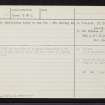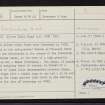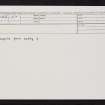Torvaine, Caledonian Canal
Chain (Silver)(Period Unassigned)
Site Name Torvaine, Caledonian Canal
Classification Chain (Silver)(Period Unassigned)
Alternative Name(s) Inverness; Torvean
Canmore ID 13495
Site Number NH64SE 14
NGR NH 6542 4346
Datum OSGB36 - NGR
Permalink http://canmore.org.uk/site/13495
- Council Highland
- Parish Inverness And Bona
- Former Region Highland
- Former District Inverness
- Former County Inverness-shire
NH64SE 14 6542 4346.
(NH 6542 4346) Silver Chain found A.D. 1808 [NAT]
OS 6" map, (1938)
A massive silver chain found near Inverness in 1809, was presented to the Antiquaries' Museum as Treasure Trove In 1837. It was discovered in the course of the formation of the Caledonian Canal, at the base of a high gravelly ridge known as Tor a Bhean (Torvaine). The chain, 18 inches in length and weighing about 93 ounces, is formed of a double series of large plain unormamented circular rings, 16 pairs of rings with a single ring at one end - 33 in all; not including the large grooved link which is now wanting (NSA gives the date of discovery as 1808).
J A Smith 1875; The Scot's Magazine 1810; NSA 1845; D Wilson 1863.
This chain is tentatively dated to the 6th - 8th century AD.
A J H Edwards 1939; R B K Stevenson 1955.
Found 1 Jan 1808 in the side of a large flat cairn 2 ft deep. It was hinted that a ball and bar, also of silver, were also found.
J Barron 1900; Information from A M Robertson to OS 1 May 1974.
'Some labourers, while digging in the eastern corner of Torvean,, on the line of the Caledonian Canal, lately discovered a massy silver chain, in the side of a large, flat cairn, about 2 feet below the surface. The chain consists of 33 circular links, formed of a perfectly cylindrical body, half-an-inch thick, neatly joined without solder. They are linked in pairs, each of which is about 2 inches in diameter, except those at the extremities, which are 21 inches. A link at one of the ends has, since the discovery of the chain, been taken away; but as the remaining one is of the same dimensions with those at the other end, we may conclude that the chain was then entire. Its whole length is 18 inches, weighing about 104 ounces.'
There were two detached fragments which formed part of a flat and very massy ring, which had been broken after it was found; but from its form, and the appearance of wearing on the outside, it had evidently moved on some bolt. It was neatly channelled round, leaving a prominent astragal on every side. 'Both the chain and ring are of excellent workmanship; and whether we attend to the uniform thickness and polish of the links, the ingenuity with which they are joined, or the perfect symmetry of the whole, we cannot but pronounce it to have been the work of an artist of no inconsiderable skill.'
The Editor adds that it was hinted that other articles bad been found, according to report a ball and bar also of silver; but the labourers kept the matter a profound secret, as steps had been taken to compel the owner of the chain to deliver it up to the Crown. 'The chain is now in the Antiquarian Museum in Edinburgh.'
Source: Inverness Journal, 1 January 1808
(Information from Mr T Cowie, Dept. of Archaeology, National Museums of Scotland, 10 December 2002).














